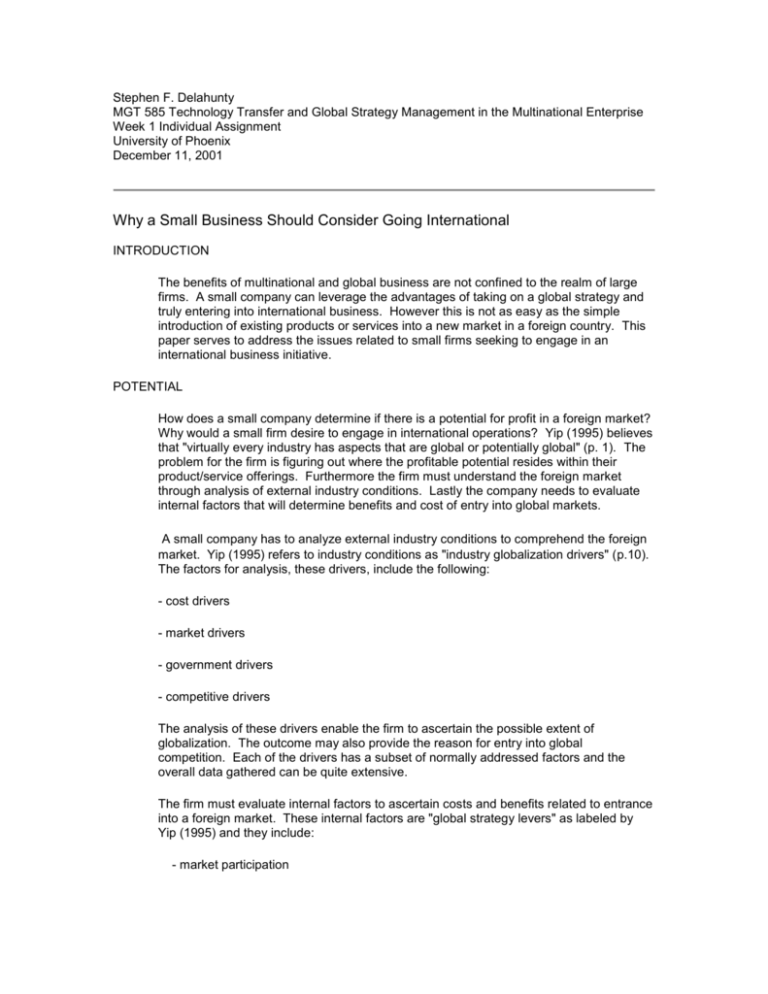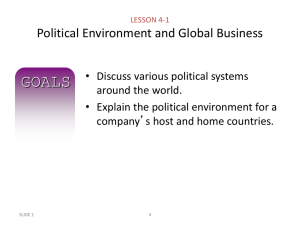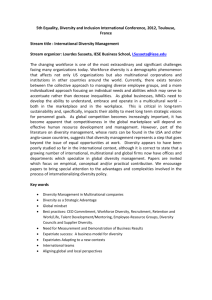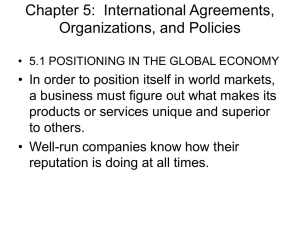Stephen F
advertisement

Stephen F. Delahunty MGT 585 Technology Transfer and Global Strategy Management in the Multinational Enterprise Week 1 Individual Assignment University of Phoenix December 11, 2001 Why a Small Business Should Consider Going International INTRODUCTION The benefits of multinational and global business are not confined to the realm of large firms. A small company can leverage the advantages of taking on a global strategy and truly entering into international business. However this is not as easy as the simple introduction of existing products or services into a new market in a foreign country. This paper serves to address the issues related to small firms seeking to engage in an international business initiative. POTENTIAL How does a small company determine if there is a potential for profit in a foreign market? Why would a small firm desire to engage in international operations? Yip (1995) believes that "virtually every industry has aspects that are global or potentially global" (p. 1). The problem for the firm is figuring out where the profitable potential resides within their product/service offerings. Furthermore the firm must understand the foreign market through analysis of external industry conditions. Lastly the company needs to evaluate internal factors that will determine benefits and cost of entry into global markets. A small company has to analyze external industry conditions to comprehend the foreign market. Yip (1995) refers to industry conditions as "industry globalization drivers" (p.10). The factors for analysis, these drivers, include the following: - cost drivers - market drivers - government drivers - competitive drivers The analysis of these drivers enable the firm to ascertain the possible extent of globalization. The outcome may also provide the reason for entry into global competition. Each of the drivers has a subset of normally addressed factors and the overall data gathered can be quite extensive. The firm must evaluate internal factors to ascertain costs and benefits related to entrance into a foreign market. These internal factors are "global strategy levers" as labeled by Yip (1995) and they include: - market participation - products/services - location of value-adding activities - marketing - competitive moves The outcome of such analysis could determine the course for the firm that they not enter into global operations due to excessive costs and limited profit potential. A firm that did not do this requisite research may have otherwise moved forward with an eventually dismal venture. Likewise the small company can use the data gathered in this evaluation of internal factors to show that they have strong marketing that could enable easier entrance into a foreign market or possibly products/services that are easily marketed in other cultures and so forth. Verma (2001) notes that a "company may realize cost benefits by using standardized products, services, manufacturing processes and a network of marketing and distribution channels". Any one of these areas could foster the ability of the small firm to enter into the foreign market. GLOBALIZATION A firm engaging in international sales may not truly be a global business and rather may be merely a multinational enterprise. A multinational firm is one that has operations in multiple countries but not truly integrated into an overall strategy. Verma (2001) differentiates this noting that "a multinational company has subsidiaries in various countries that design, produce and market products and/or services for the local market needs" and "whereas, a global company has these operations in different countries integrated with each other". Therefore the small firm that desires to have truly global business must seek to integrate their operations. According to Yip (1995) there are three steps in creating a successful global strategy. Basically first the firm needs a core business strategy, then internationalization, and then globalization. Foremost the firm must develop a domestic strategy prior to expanding or adapting this towards international markets. Yip (1995) notes that "without a sound core strategy on which to build, a worldwide business need not bother about global strategy" (p. 4). Next the firm must take this core strategy and internationalize this into a global strategy. However Yip (1995) contends that the company must first be successful internationally before they attempt a real global business versus multinational operations. So it would seem that the small firm already engaging in successful multinational business will have the best chance of true international business operations through their use of a global strategy. CULTURAL ISSUES If the small business does their analysis of internal factors and external industry conditions they still need to look into cultural issues in their target market. Just because the firm's products/services sell well in the United States this does not necessarily translate into success in foreign countries. The firm should evaluate the impact of their product/service to be offered in light of the culture(s) involved in the market. Business periodicals and texts are littered with examples of cultural mistakes made by businesses in their foreign operations. Ferraro (2002) shows the importance of cultural issues "whether dealing with dealing with issues of marketing, managing, or negotiating, the success or failure of a company abroad depends on how its employees can exercise their skills in a new location" (p. 7). More importantly Ferraro (2002) notes that "successful international marketing requires an intimate knowledge of the cultures found in foreign markets" (p. 30). Thus it can be seen that the small firm must understand their foreign market well in order to best foster successful sales. Verma (2001) notes some of the ways in which a firm can leverage assistance in foreign markets such as "international/cross-cultural alliances, joint ventures, licensing agreements, turnkey projects, foreign capital investments, etc". Using such methods the small company can avoid some costly endeavors through the use of solid business techniques. Costs for entry into the market can be a barrier for the small firm which cannot afford large initial outlays. So it is critical that the company take advantage of potentially beneficial situations. This is noted in a cultural context since the small firm should strive to use local knowledge when possible in these alliances, agreements, etc. One other cultural factor that the firm must keep in mind is that all cultures change. Therefore the product that is selling well today may not fit into the culture of the market tomorrow. Ferraro (2002) confirms that "all cultures experience continual change" (p. 29). However this need for adoption to cultural change by the firm is not really much different than the business need to continue development of new products in order to meet competition. Innovation is required for success by any firm whether-or-not the company is involved in global endeavors. It should also be noted that foreign cultures adopt innovations differently than domestic markets. Ferraro (2002) shows five variables that affect the adoption of innovations in other cultures and these include relative advantage of the product/service, compatibility with existing cultural aspects, complexity of the innovation, trialability for testing of the product/service, and observability to see the positive impact of the innovation. A small firm should evaluate their innovation in light of these variables in the possible foreign market. CONCLUSION If properly executed, a small firm can enter into successful international business. However a truly successful global enterprise is not just the entrance into multinational markets. A truly global strategy is needed where the small firm can take advantage of their strengths in various areas. In addition to analyzing external conditions and internal factors of the business for entering into international markets the firm must address cultural issues to ensure the proper placement and adoption of their product or service. REFERENCES Yip, G. (1995). Total Global Strategy: Managing for Worldwide Competitive Advantage. Prentice-Hall. Ferraro, G. (2002). The Cultural Dimension of International Business. Prentice-Hall. Verma, K. (2001). Lecture Notes. Technology Transfer and Global Strategy Management in the Multinational Enterprise. University of Phoenix.










